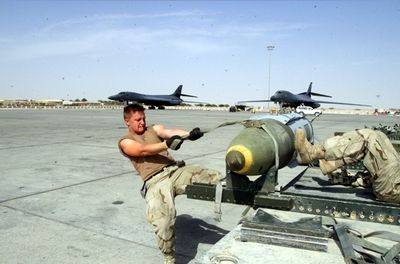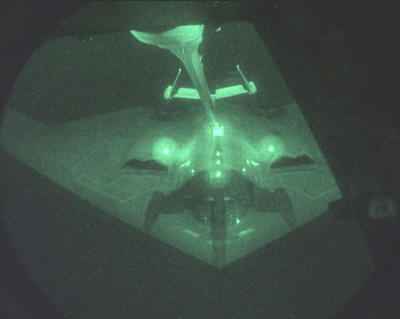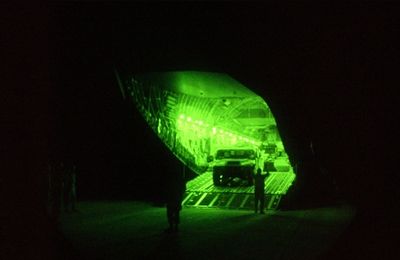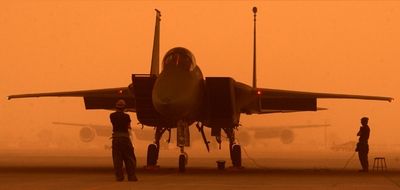The Hidden War
 Americans
see the tanks driving through Baghdad, but what they really don't
see is the air campaign that helped make it possible.
Americans
see the tanks driving through Baghdad, but what they really don't
see is the air campaign that helped make it possible.
The main beneficiaries of the air campaign are the young
soldiers and Marines driving into the heart of the Iraqi capital is
the view of the combined forces air component commander in the
theater.
"Along the way there's going to be someone, somewhere who will
want an accounting scheme of who killed what vehicle," said Air
Force Lt. Gen. T. Michael Moseley. "But right now that isn't
important to us, and it's not important to that lieutenant or
captain (commanding a unit on the ground). I just say we've killed
a hell of a lot of them; we're going to keep killing them until
they quit moving."

Something Different In The Air
As coalition forces move into Baghdad, the air campaign is
changing, said Moseley from his headquarters in Saudi Arabia today
in an interview.
He's in charge of air assets in the theater. These include the
aircraft of five US Navy aircraft carriers in the Persian Gulf and
Mediterranean; US Air Force units based at more than 30 bases in
the theater and some outside it; Marine aviation aboard the
carriers and on land; and Royal Air Force and Royal Australian Air
Force aircraft based in the region.
As land forces move into the city, the nature of air support
will change. Moseley said the coalition will maintain airborne
forward air controllers over the city 24 hours a day. These airmen
will act as liaisons with ground forward air controllers and any
number of aircraft "stacked" over Baghdad. Different types of
aircraft with different sets of munitions will be ready to support
ground forces 24 hours a day.
"The close-air support problem is a challenge in the desert or
in the city, because you are delivering weapons in close proximity
of friendly troops," Moseley said. "It's a little more of a
challenge in an urban setting because of the civilians that are
there that you are trying to liberate."

That's Not New
The coalition aircraft have dealt with this before. The US
military has studied the problems associated with close-air support
in an urban setting, and experiences in operations over Afghanistan
have given the United States an edge in this critical area of
combat.
President Bush and senior officials have stated many times: The
coalition is after the Iraqi regime, not the Iraqi people.
"The trick in doing this is to use the smallest munition
possible to get the maximum effect, so you don't create the
unnecessary loss of civilian life or property," Moseley said. "It
is interesting that we are more interested in the people and
property and structures in Baghdad than the Iraqi military is."

And sometimes the right explosive is no explosive. In especially
critical areas, the air forces can drop inert munitions - a
precision-guided bomb with no explosives inside - to take out a
target, Moseley said. This consideration continues the coalition
practice of only using precision-guided munitions inside
Baghdad.
But this is not easy, the general said. "It's only because we've
trained to do this, and only because we've spent a lot of time
worrying about this and rehearsing this that have we got to the
point where we open that concept of (operations) up to support both
the Marines and the Army with a wide variety of aircraft and
munitions," he said.
The coalition air forces have a number of missions in this
conflict, and different parts of Iraq mean a different concept of
operations. Operations in the north are different from the south,
and both are different from in the west of the country, Moseley
said.
In the north, coalition air forces work closely with special
operations forces and conventional forces. Special operations
forces are working with Kurdish groups against the regime and
against terrorist camps. The coalition air forces are hitting
strategic targets. Navy fighters from the Mediterranean are
providing most of the close-air support for coalition forces in the
north.
Coalition air forces dropped the 173rd Airborne Brigade into
northern Iraq and are running an airhead to resupply the coalition
forces.

SCUD Patrol
In western Iraq, the mission is different still. There, one
aspect is stopping Iraq from firing ballistic missiles at its
neighbors, Moseley said. Coalition air forces also work with
coalition special operations forces holding airfields in the
region.
In the south, coalition air forces switched rather quickly from
strategic targets to support to land component forces.

They did all this while other coalition aircraft were hitting
regime targets, conducting intelligence, surveillance and
reconnaissance missions, airlifting supplies and people and hitting
Iraqi air defense sites.
Moseley specifically mentioned the critical role tanker aircraft
have played in any air campaign. From March 19 through April 3,
coalition tankers had transferred 30 million gallons of jet
fuel.
But air responsibility doesn't end at the atmosphere. Moseley
said there are more than 50 satellites supporting land, sea and air
component commanders. He said they have been unbelievably capable,
supporting all aspects of the campaign.
 ANN's Daily Aero-Linx (04.13.24)
ANN's Daily Aero-Linx (04.13.24) ANN's Daily Aero-Term (04.13.24): Beyond Visual Line Of Sight (BVLOS)
ANN's Daily Aero-Term (04.13.24): Beyond Visual Line Of Sight (BVLOS) Airborne 04.09.24: SnF24!, Piper-DeltaHawk!, Fisher Update, Junkers
Airborne 04.09.24: SnF24!, Piper-DeltaHawk!, Fisher Update, Junkers Aero-News: Quote of the Day (04.14.24)
Aero-News: Quote of the Day (04.14.24) ANN's Daily Aero-Term (04.14.24): Maximum Authorized Altitude
ANN's Daily Aero-Term (04.14.24): Maximum Authorized Altitude








